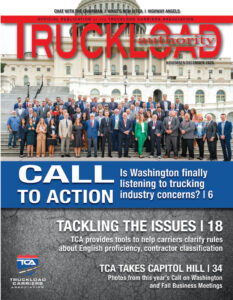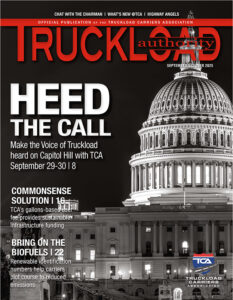The Commercial Vehicle Safety Alliance’s new out-of-service regulations are now in effect ahead of the agency’s International Roadcheck event, scheduled for May 16-18. Meanwhile, the White House is set to review a proposed plan to require automatic emergency braking on big trucks. Also in Washington, the National Highway Traffic Safety Administration reports that traffic deaths were up in 2021. In Congress, there are efforts to reconsider tax credits to address the truck driver shortage, which was only amplified by the COVID-19 pandemic. These issues, along with other news affecting the trucking industry, are explored in the following stories.
White House reviewing proposal to require automatic emergency braking on big rigs
The White House is now reviewing a National Highway Traffic Safety Administration (NHTSA) proposal to require automatic emergency braking (AEB) systems on heavy trucks.
The president’s office must approve the proposal before it can be published in the Federal Register, where it will receive public comment before regulators decide whether it should become law.
“This joint rulemaking of the NHTSA and Federal Motor Carrier administration will be seeking comments on a proposal to require and/or standardize equipment performance for AEB systems on heavy trucks (2127-AM36),” a federal report filed with the Office of Information and Regulatory Affairs notes. “The rulemaking is expected to propose performance standards and motor carrier maintenance requirements for AEB systems on heavy trucks and accompanying test procedures for measuring the performance of the AEB systems in NHTSA compliance testing.”
The Insurance Institute for Highway Safety (IIHS), a research group supported by auto insurers, found in a 2020 study that automatic emergency braking and forward collision warnings could prevent more than 40% of crashes in which semis rear-end other vehicles. The study found that when rear collisions happened, the systems cut speeds by more than half, reducing damage and injuries.
NHTSA had proposed a regulation on automatic emergency braking in 2015, but it languished in the regulatory process.
In 2016, NHTSA brokered a deal with 20 automakers representing 99% of U.S. new passenger vehicle sales to voluntarily make automatic emergency braking standard on all models by September 1, 2022. However, that deal did not apply to big rigs.
The Owner-Operator Independent Drivers Association, in its publication LandLine, recently quoted OOIDA’s director of federal affairs, Jay Grimes, on the issue.
“We certainly have concerns about AEB technology and how it will work in certain driving conditions, most notably at night,” Grimes said. “We want to make sure these systems are not giving off false alarms and false detections that distract drivers and take the control out of their hands.”
IIHS STUDY
Equipping large trucks with forward collision warning and AEB systems could eliminate more than two out of five crashes in which a large truck rear-ends another vehicle, according to the IIHS study.
Eric Teoh, director of statistical services for IIHS, examined data on crashes per vehicle mile traveled from 62 carriers operating tractor-trailers and other trucks weighing at least 33,000 pounds. He found that trucks equipped with forward collision warning had 22% fewer crashes, while trucks with AEB had 12% fewer crashes than those without either technology. Forward collision warning and AEB reduced rear-end crashes, the specific type of collision they’re designed to prevent, by 44% and 41%, respectively.
Although drivers of large trucks crash less often per mile traveled, these trucks can be especially deadly because they can weigh 20 to 30 times as much as passenger vehicles. U.S. crashes involving large trucks have risen by nearly a third since hitting an all-time low in 2009, with 4,136 people killed in 2018. Among those fatalities, 119 deaths resulted from large trucks rear-ending passenger vehicles.
Overall, Teoh’s study covered about 2,000 crashes that occurred over more than 2 billion vehicle miles traveled during 2017-2019. The analysis excluded incidents that weren’t serious enough to result in injury or significant property damage.
“This study provides evidence that forward collision warning and AEB greatly reduce crash risk for tractor-trailers and other large trucks,” Teoh said. “That’s important information for trucking companies and drivers who are weighing the costs and benefits of these options on their next vehicles.”
Front crash prevention systems use cameras, radar, or other sensors to monitor the roadway ahead. Some include only forward collision warning, which alerts the driver to obstacles in the roadway. AEB systems go further, automatically applying the brakes to prevent a collision or reduce its severity. The European Union has required AEB with forward collision warning on most new heavy trucks since November 2013. The number of large trucks equipped with AEB is increasing, but there have been few studies of its effect on crash rates.
In the large-truck study, Teoh compared trucks from the same carriers that were equipped with forward collision warning alone, AEB and no front crash prevention at all (AEB systems generally include forward collision warning too).
For the first time, the IIHS drew on data compiled by SmartDrive Systems, a video-based safety program for commercial fleets. SmartDrive was able to determine which trucks were equipped with forward collision warning and AEB and collect detailed information about crashes. Using data collected by a third party helped to minimize data differences among carriers that might have influenced the results.
The similar benefits of forward collision warning and AEB that Teoh observed for rear-end crashes were unexpected, since studies of passenger vehicles have shown AEB to be much more effective than systems that only issue warnings. These findings could reflect differences in how and by whom trucks and passenger vehicles are driven; or the differences could be connected to variations among the specific systems used by each carrier.
The study indicated AEB and forward collision warning are both likely to have benefits beyond a reduction in crashes. Some crashes that aren’t prevented by the systems are made less severe, thanks to a reduction in impact speed. This is true whether it’s the automated system applying the brakes or a human driver who has more time to react because of a warning.
In reviewing the trucks that rear-ended other vehicles, Teoh found that either system resulted in speed reductions of more than 50% between the warning or automatic braking and the impact.
“The potential benefits are great enough that these crash avoidance systems should be standard equipment on all new large trucks,” said IIHS President David Harkey.
CVSA’s 2023 Out-of-Service Criteria now in effect

The Commercial Vehicle Safety Alliance’s (CVSA) 2023 North American Standard Out-of-Service Criteria went into effect April 1, 2023, replacing and superseding all previous versions, according to a CVSA news release.
“CVSA’s North American Standard Out-of-Service Criteria ensure uniformity, consistency, and reciprocity among the states, provinces, territories and countries and determine whether or not drivers or vehicles present an imminent hazard and should be placed out of service,” the news release stated. “The federal regulations, together with CVSA’s out-of-service criteria, provide the standards that drivers, motor carriers and law enforcement personnel use to ensure the commercial motor vehicles and drivers operating on North America’s roadways are safe and compliant.”
The voting members of the CVSA approved nine changes to the out-of-service criteria. In accordance with the CVSA Bylaws, the proposed changes were communicated to the voting members of the CVSA on Oct. 10, 2022, and ratified on Oct. 21, 2022. The out-of-service criteria are updated annually, effective April 1 of each year.
The following changes were made to the out-of-service criteria:
- A section of the paragraph in Part I, Item 4. DRIVER MEDICAL/PHYSICAL REQUIREMENTS – b. Medical Certificate (4) was removed to provide more clarity.
- Part I, Item 7. DRUGS AND OTHER SUBSTANCES – b. Shall Not be Under the Influence was amended to add language for use within the previous 24 hours.
- Part I, Item 9. U.S./Item 10. CANADA/Item 11. MEXICO – DRIVER’S RECORD OF DUTY STATUS was amended to clarify the out-of-service condition for a false record of duty status.
- Part I, Item 9. DRIVER’S RECORD OF DUTY STATUS – U.S. – Footnote 10 was amended to clarify that a driver is not out of service for not being able to print or sign their record of duty status.
- The severity of rust required on a rotor to be included in the 20% brake criterion was clarified in Part II, Item 1. BRAKE SYSTEMS – a. Defective Brakes, (6) Air Disc Brakes (d), (7) Hydraulic and Electric Brakes (e) and b. Front Steering Axle(s) Brakes, (3) Air Disc Brakes (e), (4) Hydraulic Brakes (e).
- Part II, Item 2. CARGO SECUREMENT – e. (3) and f. NOTE was amended to clarify that there is nothing in the Federal Motor Carrier Safety Regulations or National Safety Code Standard 10 dictating the placement of tiedowns on cargo.
- “To Be On” was added to the title of Part II, Item 9. LIGHTING DEVICES (Headlamps, Tail Lamps, Stop Lamps, Turn Signals and Lamp/Flags on Projecting Loads), a. When Lights are Required.
- Clarifying language for spring hangers and equalizers was added to Part II, Item 11. SUSPENSION – d. Suspension Connecting Rod and Tracking Component Assembly.
- A diagram was added to Part II, Item 11. SUSPENSION – d. Suspension Connecting Rod and Tracking Component Assembly for further clarification of parts and how they apply to the out-of-service criteria.
CVSA’s International Roadcheck set for May 16-18

It’s almost here: The Commercial Vehicle Safety Alliance’s (CVSA) 2023 International Roadcheck is set for May 16-18. International Roadcheck is a high-visibility, high-volume 72-hour inspection and enforcement event where CVSA-certified inspectors in Canada, Mexico, and the U.S. conduct inspections of commercial motor vehicles and drivers at weigh/inspection stations, designated inspection areas, and along roadways.
This year, inspectors will focus on anti-lock braking systems (ABS) and cargo securement to highlight the importance of those aspects of vehicle safety, according to the CVSA.
Although ABS violations are not out-of-service violations, the CVSA notes that “ABS play a critical role in reducing the risk of collisions by preventing the wheels from locking up or skidding, allowing a driver to maintain control of the vehicle while braking. In addition, improper cargo securement poses a serious risk to drivers and other motorists by adversely affecting the vehicle’s maneuverability, or worse, causing unsecured loads to fall, resulting in traffic hazards and vehicle collisions.”
During the International Roadcheck, inspectors will conduct their usual roadside safety inspections of commercial motor vehicles and drivers. Data will be gathered during the three-day period and shared later this year as a snapshot of the state of commercial motor vehicle and driver safety.
The International Roadcheck also provides an opportunity to educate the motor carrier industry and general public about the importance of safe commercial motor vehicle operations and the North American Standard Inspection Program.
During a routine North American Standard Level I Inspection, inspectors focus on both vehicle and driver safety and compliance.
- Vehicle safety: Inspectors will ensure the vehicle’s brake systems, cargo securement, coupling devices, driveline/driveshaft components, driver’s seat, fuel and exhaust systems, frames, lighting devices, steering mechanisms, suspensions, tires, wheels, rims, hubs, and windshield wipers are compliant with regulations. Inspections of motorcoaches, passenger vans and other passenger-carrying vehicles also include emergency exits, seating, and electrical cables and systems in the engine and battery compartments.
- Driver safety: Inspectors will check the driver’s operating credentials, hours-of-service documentation, status in the Drug and Alcohol Clearinghouse, and seat belt usage, and watch for signs of alcohol and/or drug impairment.
Vehicles that successfully pass a Level I or Level V Inspection without any critical vehicle inspection item violations may receive a CVSA decal, which is valid for three months. If the inspector does identify critical vehicle inspection item violations, as outlined in the North American Standard Out-of-Service Criteria, the vehicle will be restricted from operating until the identified out-of-service conditions have been corrected. Inspectors may also restrict the driver from operating if the driver is found to have driver out-of-service violations, such as not possessing a valid or necessary operating license or exhibiting signs of impairment.
Distraction, speeding, alcohol drive up traffic deaths in 2021, NHTSA reports show

Statistics from the National Highway Traffic Safety Administration (NHTSA) show nearly 43,000 people died in U.S. traffic crashes in 2021, the highest number in 16 years, with deaths due to speeding and impaired or distracted driving on the rise.
The final figures for 2021, released in April, confirmed earlier estimates by the agency showing a 10.5% increase in deaths over 2020. That’s the highest number since 2005 —and the largest percentage increase since 1975.
Data shows a 12% rise in fatal crashes involving at least one distracted driver, with 3,522 people killed. That prompted the agency to kick off a $5 million advertising campaign in an effort to keep drivers focused on the road. Agency officials said such cases likely are underreported by police.
Speeding-related deaths increased 7.9%, while crash deaths involving large trucks weighing more than 10,000 pounds were up 17%. The number of pedestrians killed rose 13%, and cyclist fatalities were up 2% for the year. The number of unbelted passengers killed rose 8.1%, while fatalities involving alcohol-impaired driving were up 14%.
At a news conference held in Seattle April 3, NHTSA focused on distracted driving fatalities, which speakers said are entirely preventable — if drivers stop using cellphones, eating, or doing other things that divert attention from the road.
“Remember it only takes a moment to change your life forever,” said Sophie Shulman, NHTSA deputy administrator.
Steve Kiefer, a retired General Motors executive whose son, Mitchel Kiefer, was killed in a 2016 distracted driving crash, said cellphones are a primary cause of distraction. But technology is available to prevent this, including “do not disturb” modes, as well as apps and in-car systems that watch drivers to make sure they’re paying attention.
“All of this technology is available today, and there’s no reason we can’t use it and roll it out quickly,” Kiefer said.
Distracted driving deaths are related to America’s addiction to cellphones, said Kiefer, who started a foundation with a goal of ending distracted driving. He said 90% of people are aware of the danger of distracted driving, yet 80% admit to doing it. In 25 states with laws against hand-held cellphone use, traffic deaths, crashes and insurance rates have dropped, he said.
“We believe that legislation will change behavior,” Kiefer said.
Kiefer’s son was killed while driving on Interstate 96 when traffic slowed and his car was hit from behind by a driver who was distracted by her phone. His car was knocked across the median and into oncoming traffic, where he was killed instantly. The crash was not reported as involving a distracted driver, illustrating how distracted driving deaths are underreported, Kiefer said.
Part of the increase in crash deaths is due to people driving more as the COVID-19 pandemic waned. NHTSA reported that the fatality rate per 100 million vehicle miles traveled increased 2.2% to 1.37 in 2021. NHTSA also estimates that 2.5 million people were injured in crashes during 2021, up 9.4% from 2020.
NHTSA estimates that 31,785 people were killed in crashes from January through September of 2022, down 0.2% from the same period of 2021.
Safest roads for truck drivers are in Michigan, new study notes

Michigan highways are the safest in the nation for truck drivers, according to a new study conducted by transportation services company Simplex.
Using 2022 data from the National Highway Traffic Safety Administration (NHTSA), the survey also found that Vermont is the second safest state for truck drivers, followed by Hawaii. Wyoming was ranked as the least-safe state, followed by Idaho and Nebraska.
The study measured the percentage of large trucks involved in fatal crashes in 2022 compared to all fatal vehicle crashes per state to declare the state with the least percentage of truck incidents as the safest for truck drivers.
Michigan was revealed as the safest state for truck drivers on the road, with just 4.72% of its fatal crashes involving large trucks. The state recorded 1,567 vehicles involved in life-threatening crashes, and 74 large truck crashes were recorded by the NHTSA. According to the Michigan Department of Transportation, road fatalities fell by 2.9% between 2018 and 2022, with serious injuries lowered by 10.6%.
Vermont is the second safest state for truck drivers, with 5% of fatal vehicle crashes involving large trucks. Although Vermont recorded 80 vehicles involved in life-threatening crashes, four large trucks were associated with these incidents in 2022. In third place is Hawaii, with a 5.26% of fatal vehicle crashes involving a truck in the 12-month period. The state recorded 114 vehicles associated with life-endangering crashes on Hawaii’s roads, six of which involved large trucks.
The fourth safest state road for truck drivers is Delaware, with 5.56% of fatal vehicle crashes involving a truck. The state saw 162 vehicles associated with life-threatening crashes, and nine including large trucks. In fifth place is Massachusetts, showing a 5.74% truck-involved fatal crash rate. The report shows 488 drivers using this state’s roads have been involved in a life-endangering crash in 2022; 28 of them were truck drivers.
Wyoming proves to be the least-safe state for truck drivers, with 33% of the state’s 174 fatal vehicle crashes involving large trucks. This equates to 18.97% of the state’s total crashes involving large trucks.
Following behind is Idaho with 16.33%, with 49 out of 300 vehicles associated with a life-threatening crash involving trucks. Nebraska is the third least-safe state for truck drivers, with a 15.92% truck-involved fatal crash rate in 2022. This translates to 53 large trucks out of 333 vehicles. Iowa is the fourth dangerous state for truck drivers, with 14.35% of fatal 2022 vehicle crashes involving a truck, translating to 67 large trucks out of 467 vehicles. North Dakota has the fifth least-safe roads for truck drivers, with 13.24% of fatal vehicle crashes involving a large truck in 2022, equating to 18 out of 136 vehicles.
“This research offers an interesting insight into which states are nearing the goal of making roads safer for truck drivers. It also highlights the states that might need to consider implementing more truck-safe road systems for drivers,” noted a Simplex spokesperson. “According to the NHTSA, there have been 4,842 large trucks involved in fatal crashes in the past year, so this study could alert truck drivers to prepare better when journeying in these particular states.”
Truck driver wages remain on the upswing

According to the National Transportation Institute’s (NTI) National Driver Wage Index, which measures on a quarter-sequential and annual basis the momentum of driver pay changes and tracks wages (mileage and hourly base pay) across segments, fleet type, region, and driver job type, the pay scale has seen growth over the past 13 years.
“Wage momentum has never turned negative since the Great Recession,” the NTI report notes. “Starting in 2010, every year over the past 13 has seen growth in the wages fleets are paying professional drivers. That’s through the mini freight recession in 2016 and 2017, the economic upswing and capacity crunch in 2018, the correction cycle of 2019, and then the oscillating economic cycles of the COVID and post-COVID era.”
A 2022 survey conducted by the American Trucking Associations (ATA), which included 185 fleets, more than 135,000 employee drivers, and nearly 20,000 independent contractors, with data broken down by for-hire truckload carriers, less-than-load carriers and private fleets, showed that truckload drivers were paid an estimated median annual amount of $69,687 in 2021, including salaries and bonuses but not benefits.
This figure reflects an 18% increase in annual compensation from ATA’s 2019 study and emphasizes the increase in demand for drivers in this sector.
Independent contractors at truckload carriers performing non-drayage activities were paid an estimated median annual amount of $235,000 in 2021.
More than 90% of truckload respondents raised driver pay in 2021, offering an average increase of 10.9%. A total of 96% truckload carriers offered a referral bonus to employee drivers with a median value of $1,150 — which is $150 higher than the last ATA survey indicated.
This was in conjunction with a $750 increase in the median sign-on bonus offered by 54% of truckload carriers.
Less-than-truckload drivers who hauled fright over-the-road were paid an estimated median amount of $73,000 in 2021. Less-than-truckload employee drivers on local routes were paid an estimated median amount of $55,000 last year.
Private carriers paid their employee drivers an estimated median amount of $85,000 in 2021, the same value reported in our 2019 study. Seventy-six percent of private carriers offered a referral bonus to employee drivers with a median amount of $1,150 — which is $250 higher than the last survey indicated.
This was in conjunction with a $4,000 spike in the median sign-on bonus offered by 76% of private carriers.
Congress to reconsider tax credits to address truck driver shortage
According to industry analysts, the U.S. faces a shortage of truck drivers, and steps have already been taken to address the issue. The industry has engaged in an effort to make the career field appealing to an under-represented segment of the nation’s workforce in recent years through recruiting more female drivers. In addition, the National Transportation Safety Board has been considering lowering the qualifying age for interstate drivers — particularly those with military driving experience — for some time.
The COVID-19 pandemic only amplified the shortages and the pressing need to recruit more truck drivers.
“During the pandemic, truckers didn’t have any remote options — yet they went to work every single day to keep our economy moving and our communities strong,” said Rep. Abigail Spanberger (D-VA). With the support of co-sponsor Rep. Mike Gallagher (R-WI), a new round of legislation is making its way through the halls of Congress, which will hopefully make careers in trucking more appealing to the workforce.
And this time, Congress is putting its money where its mouth is.
In early April, the bipartisan Strengthening Supply Chains through Truck Driver Incentives Act was reintroduced to Congress after failing to gain traction in 2022. The co-sponsors developed the legislation to provide financial incentives to qualified drivers through refundable tax credits. The credits are intended to make truck driving a more lucrative career — one that is more appealing to new drivers, and one that can retain those who have already chosen trucking as a career.
The bill’s provisions for tax credits address three areas.
- First, it will create a new refundable credit of up to $7,500 for Class A CDL drivers who log at least 1,900 hours during the year (an average of about 37 hours per week). The credit is planned for two years (2023 and 2024).
- Second, a new refundable credit of up to $10,000 would apply to new drivers or prospective drivers enrolled in a registered trucking apprenticeship (also for 2023 and 2024).
- Finally, the bill will allow new drivers to be eligible for the credit if they did not drive a commercial truck in the previous year or drive at least 1,420 hours in the current year. New CDL holders who drive less than 1,420 hours for the year — but at least an average of 40 hours a week once they begin to drive professionally — would be eligible to receive a partial credit.
According to Gallagher, passage of the bill would do more than simply increase the number of young men and women who consider trucking as a career path.
“This bipartisan bill is a commonsense way to recruit and retain more drivers to keep our shelves stocked and our economy moving,” he said.
The bill has been referred to the House Ways and Means Committee for consideration.
This article originally appeared in the May/June 2023 edition of Truckload Authority, the official publication of the Truckload Carriers Association.
The Truckload Authority News Staff, comprised of award winning journalists and graphic artists, produces content for Truckload Authority, working in cooperation with the Truckload Carriers Association staff. Truckload Authority aims to keep TCA members abreast on the latest trends in the trucking industry as well as articles that feature TCA member executives and drivers. The Truckload Authority staff is based in Little Rock, Arkansas.














